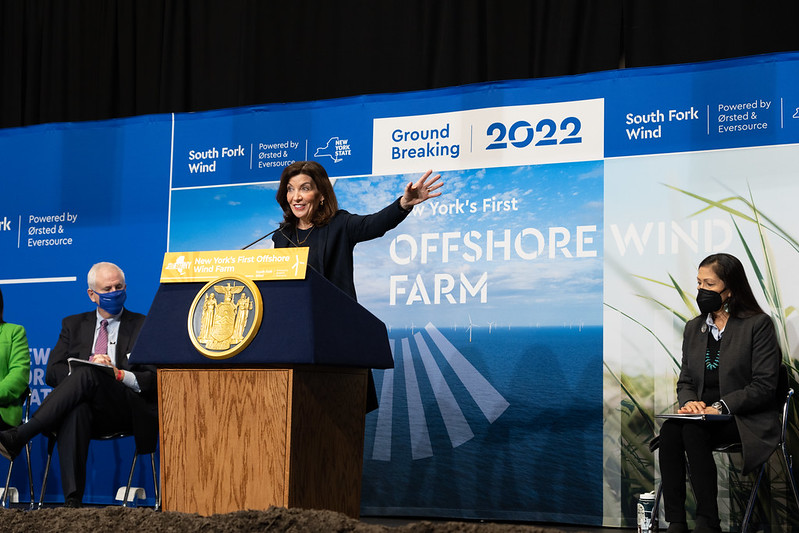
Gov. Hochul makes an offshore wind announcement (photo: office of Governor Hochul)
With 500,000 acres set for offshore wind development in the New York Bight and Governor Kathy Hochul’s investment of $500 million to support the industry earlier this year, New York is well-positioned to scale the sector from the ground-up the right way: with a focus on equity, community benefits, and reversing the historic impacts of environmental racism, which for decades concentrated noxious infrastructure in predominantly lower-income communities of color that had no say in the process.
But to realize an equitable transition to wind energy and sustain a thriving industry, we need more than traction within the private sector. We need New York policymakers to make the same all-in commitment the city and state made over the past decade in boosting another high-performing sector with untapped potential: life sciences.
The New York City Economic Development Corporation (EDC) recently announced the city is home to more life science employment opportunities than any metropolitan region in the country. That’s a quantum leap from the 1990s. So, what changed?
Over the past 15 years, the city and state implemented a comprehensive strategy, encompassing a variety of programmatic initiatives and cross-sector collaboration — from sponsoring the development of a world-class technology innovation and academic hub on Roosevelt Island, to offering incentives for commercial life science development through the EDC’s IDA program, to facilitating internship programs to bring youth into companies, to committing $1 billion through the city’s LifeSci NYC initiative; to supporting new life science businesses in New York through the state’s Life Sciences Tax Credit program.
For offshore wind, we need the same kind of thoughtful programmatic interventions, including academic partnerships supporting energy research and workforce development, city- and state-funded incubators, internships for young adults, industry networking events and education programs, and training and support for MWBEs seeking to break into the sector.
Some of this work is underway. The New York Energy Research and Development Authority (NYSERDA) has set a precedent for inclusive development by mandating 30% MWBE inclusion. Last year NYSERDA also developed, with the support of my team at Karp Strategies, an offshore wind curriculum for teenagers that is now available online as a resource for any middle school or high school classroom in New York. The NYCEDC has initiated a training program we are helping develop designed to upskill MWBE firms.
But there is still so much work to do on top of these first steps to set New York up as a clean energy leader. Here are three policies the city and state can set in motion now:
First, just as the Bloomberg administration provided Cornell Tech 12 acres of city-owned land when it won the bid to transform Roosevelt Island into an applied sciences’ campus in 2011, so the city and state today can look at property that they control, and prioritize land disposition across sites that could support the development of clean energy.
EDC has taken a step in this direction, issuing a request for proposals (RFP) to analyze an unused site on Staten Island for potential wind energy use. Turbine components can stretch the length of a football field so proactively addressing the issue of land availability, especially waterfront property, would help mitigate a crucial bottleneck in the growth of offshore wind.
Second, the city and state should ramp up efforts to create the green and blue workforce we need for industries like offshore wind and solar to thrive. Let’s build dramatically on the state’s investment in an Offshore Wind Training Institute through a partnership of SUNY’s Farmingdale State College and Stony Brook University on Long Island.
It is critical that educational opportunities are available to people in every part of the state and we should continue investing in training programs at public colleges as Governor Hochul has at LaGuardia, Hudson Valley, and Kingsborough. Beyond partnering with academia, state and local governments should be working with employers to expand the career development opportunities available to local residents, and holding developers accountable for prioritizing workforce development in their plans.
Finally, despite New York state’s nation-leading investment in offshore wind, the reality is $500 million only scratches the surface of the funding we need to compensate for chronic underinvestment in the port infrastructure that we must now modernize. The city and state need to go well beyond the $1 billion that New York City alone has committed to fostering the life sciences industry in order to address deferred maintenance that will choke the growth of offshore wind.
With so much momentum behind the growth of New York’s offshore wind industry at the city, state, and federal levels, now is the time to lean into an equitable transition to a cleaner energy system that delivers a windfall of shared economic benefits. The City and State should continue to seize this golden opportunity.
***
Rebecca Karp is Managing Principal of Karp Strategies.
***
Have an op-ed idea or submission for Gotham Gazette? Email This email address is being protected from spambots. You need JavaScript enabled to view it.




